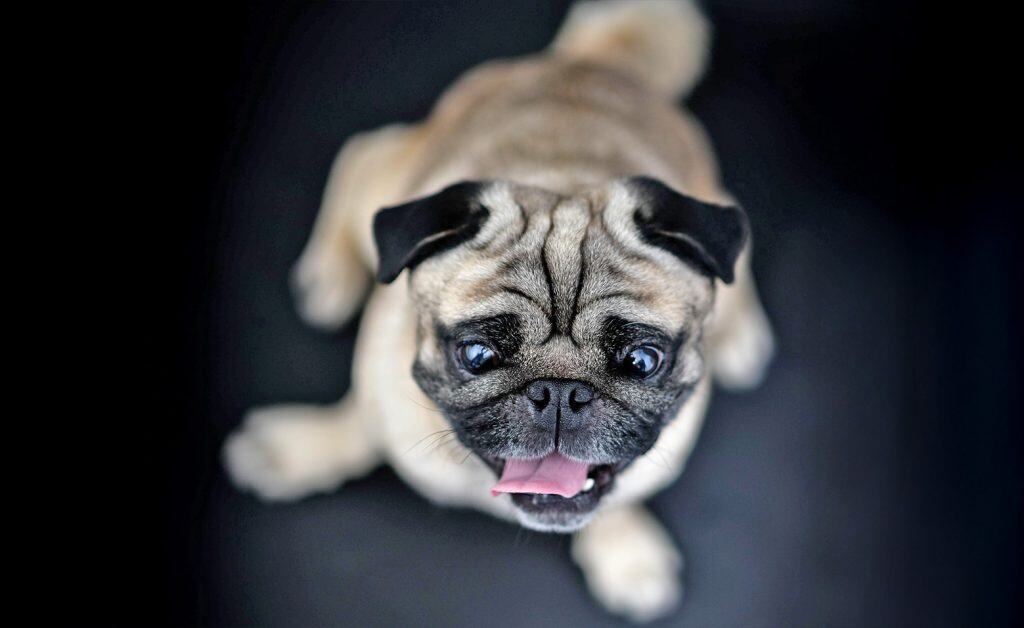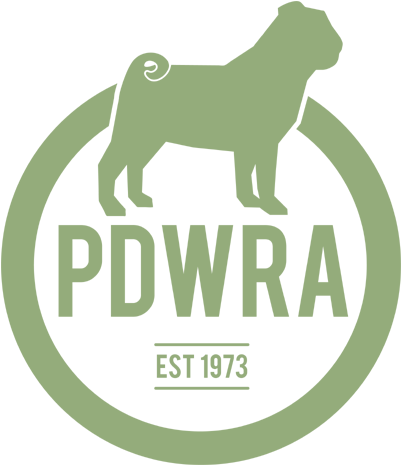Written by Helen McKee
PDWRA Veterinary Advisor
I am sure all of you, and anyone who has had a pug, is familiar with the term ‘BOAS’. It stands for Brachycephalic Obstructive Airway Syndrome’
It is a large topic and there is much to discuss about the condition, but hopefully I will keep it concise and in a way that can be understood. It’s also a controversial subject due to the impact it has on a dog’s (pug’s) health and welfare.
It’s a condition that has been created by the breeding of dogs so they have little or no snout.
This has then resulted in all the soft tissues at the back of the throat being squashed into a smaller space. The nose structure, both externally and internally, can be abnormal, but more importantly (for pugs), the soft palate (and tongue) are too large for the size of a pug’s head and throat.
The most significant part (for a pug) is an excessively long soft palate, which obstructs the airflow through the larynx (access at back of throat to lungs) into the trachea. This leads to a rattling noise or what is known as ‘stertor’, and less air being able to reach the lungs. This affects a pug’s ability to exercise (exercise intolerance) and is exacerbated by carrying any excess weight, particularly because pugs carry extra weight around their necks.
This is why the condition is controversial; we have bred a dog that can’t breathe properly, which is a welfare issue. In the Netherlands it is now illegal to breed a dog without a certain length of snout.
The condition can vary from mild to severe, with extreme cases fainting (apnoea) due to lack of oxygen. The sooner this is addressed, the better, in order to prevent secondary problems developing which cause further breathing issues.

Secondary changes can occur when the obstruction of the soft palate is left without treatment (chronic). Because the airway is blocked by the tissue, it creates a negative pressure at the back of the throat causing the larynx to collapse. With time, the laryngeal tissues become damaged and soft. The negative pressure can also cause the tonsils to evert out of their crypts, and the so-called laryngeal saccules to do likewise. These everted structures then cause further obstruction in the airway, which becomes a vicious cycle.
Dogs who have these secondary changes make a different noise, ‘stridor’, which is more like a wheeze rather than a rattle.
Another condition which results from the long-term negative pressure caused by the obstructive long soft palate, is gastric reflux. The sphincter at the top of the stomach gradually becomes loose due to this negative pressure, resulting in gastric reflux. Signs of reflux are stretching out of neck, licking lips and regurgitation.
This can become a potentially life-threatening condition, especially when a pug is anaesthetized. Material can become sucked (aspirated) into the lungs, a condition known as aspiration pneumonia. For this reason, all brachycephalic dogs should be given the medication ‘Omeprazole’ prior to a general anaesthetic.
The treatment for BOAS is surgery. If there are no secondary changes, BOAS surgery tends to involve the reduction of the soft palate and widening of narrowed (stenotic) nares. In my opinion, and in fact mentioned by Dr Rowena Packer (an expert in BOAS) in the book ‘Health and Welfare of Brachycephalic Companion Animals’, widening of a pug’s nostrils is rarely a cause of BOAS.
Quoting Dr Packer :- “Previously, stenotic nares were thought to be of paramount importance, and early treatment was advised to open the nostrils….. Recent work from the Cambridge BOAS Research Group shows that the nostrils in the French Bulldog are of particular importance (not pugs). It is worth noting that we have seen mature dogs with no BOAS-related respiratory signs yet with severely stenotic nostrils.”
This is certainly my experience; I have rarely seen narrowed nostrils in pugs causing breathing problems, and I personally feel widening a dog’s nostrils has become a bit of a trend without assessing if it’s actually causing a clinical problem.

This is a photo of our rescue pug Molly, with her significantly stenotic nostrils, however she runs 7 miles daily and breathes comfortably.
If a dog’s mouth breathes when at rest, then this indicates they are unable to breathe through their nose. However, widening the nostrils may not resolve the issue, as often there are abnormalities in the nasal structures (turbinates) due to the extremely shorted muzzle, which compromise and block airflow through the nose.
Although BOAS surgery is generally straight forward when there are no secondary changes, it is best carried out by a veterinary surgeon with experience / extra qualifications (Specialist or an Advanced Practitioner in Surgery). Swelling can occur at the back of the throat immediately post-operatively, which needs to be managed carefully. When there are secondary changes, the surgery carries a greater risk of complications, including death.
It used to be the case that surgeons would remove the laryngeal structures that had everted and were blocking the access to the windpipe (tonsils, laryngeal saccules), however, recently specialists have been removing the soft palate tissue only, as this carries less risk of bleeding and swelling post operatively, and it has been found these structures may go back into their natural position once the ongoing negative pressure is removed.
These dogs need to have close management post-operatively to watch for any signs of swelling/laryngeal collapses causing breathing difficulties. They also need to monitored for aspiration pneumonia; personally, I have had a foster dog who had severe BOAS, die of aspiration pneumonia following BOAS surgery.

Damage to the tissue of the larynx is generally irreversible causing softening of the larynx (malacia) and collapse. Laryngeal collapse is graded from one to three, with three being the worst affected. This can be managed conservatively (controlling exercise, not allowing the pug to get hot or too excited) and feeding from a height (‘fluff trough’). However, some vets will advise removal of cartilage from the larynx (arytenoid cartilage) or ‘laryngeal tieback’.
In my opinion, both procedures carry greater risk and are not a panacea, and I would not advise this to be performed on a pug; both can lead to a significant increased risk of aspiration pneumonia (where fluid/food is aspirated into the lungs) which is discussed above.
In summary, due to the abnormal shape of a pug’s head, they can suffer from obstructive breathing issues (BOAS) that can significantly and adversely affect the health and welfare of a pug. The earlier surgery is carried out, the better the outcome and the less likelihood of developing secondary changes such as laryngeal collapse and gastric reflux.
The surgery does carry risks, especially when the condition becomes chronic and the dog has developed secondary health problems, however, if a pug has clinical BOAS and it is not surgically corrected, they will have breathing difficulties which will worsen with time, affecting health, welfare and ultimately, the life of the pug.
Helen McKee
Veterinary Advisor
PDWRA
2018-2025
******
To read more about Pug Health from our website, please go to the following pages:
https://pugwelfare-rescue.org.uk/pug-health/


